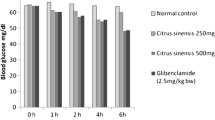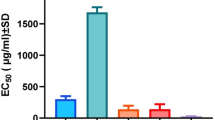Abstract
Fenugreek and Balanites are two plants commonly used in Egyptian folk medicine as hypoglycemic agents. In the present study, the effects of 21 days oral administration of Fenugreek seed and Balanites fruit extracts (1.5 g/kg bw) on the liver and kidney glycogen content and on some key liver enzymes of carbohydrate metabolism in STZ-diabetic rats were studied. In addition, the effects of these two plant extracts on the intestinal α-amylase activity in vitro and starch digestion and absorption in vivo were also examined. Results indicated that single injection of STZ (50 mg/kg bw) caused 5-folds increase in the blood glucose level, 80% reduction in serum insulin level, 58% decrease in liver glycogen and 7-folds increase in kidney glycogen content as compared to the normal levels. The activity of glucose-6-phosphatase was markedly increased, whereas, the activities of both glucose-6-phosphate dehydrogenase and phospho-fructokinase were significantly decreased in the diabetic rat liver. Administration of Fenugreek extract to STZ-diabetic rats reduced blood glucose level by 58%, restored liver glycogen content and significantly decreased kidney glycogen as well as liver glucose-6-phosphatase activity. Meanwhile, Balanites extract reduced blood glucose level by 24% and significantly decreased liver glucose-6-phosphatase activity in diabetic rats. On the other hand, our results demonstrated that both the Fenugreek and Balanites extracts were able to in vitro inhibit α-amylase activity in dose-dependent manner. Fenugreek was more potent inhibitor than Balanites. This inhibition was reversed by increasing substrate concentration in a pattern which complies well with the effect of competitive inhibitors. Furthermore, this in vitro inhibition was confirmed by in vivo suppression of starch digestion and absorption induced by both plant extracts in normal rats. These findings suggest that the hypoglycemic effect of Fenugreek and Balanites is mediated through insulinomimetic effect as well as inhibition of intestinal α-amylase activity.
Similar content being viewed by others
References
American Diabetes Association: Clinical practice recommendations. Diabetes care 20(suppl. 1): S1–S70, 1997
Perez RM, Zavala MA, Perez S, Perez C: Antidiabetic effect of two compounds isolated from plants. Phytomedicine 5: 55–75, 1998
Swanston-Flatt SK, Day C, Flatt PR, Gould BJ, Bailey CJ: Glycemic effect of traditional European plant treatments for diabetes. Studies in normal and streptozotocin diabetic mice. Diabetes Res 10: 69–73, 1989
Khosla P, Gupta DD, Nagpal RK: Effect of Trigonella foenum graecum (fenugreek) on blood glucose in normal and diabetic rats. Indian J Physiol Pharmacol 39: 173–174, 1995
Raju J, Gupta D, Rao AR, Yadava PK, Baquer NZ: Trigonella foenum graecum (fenugreek) seed powder improves glucose homeostasis in alloxan diabetic tissues by reversing the altered glycolytic, gluconeogenic and lipolytic enzymes. Mol Cell Biochem 224: 45–51, 2001
Mohamad S, Taha A, Bamezai RN, Basir SF, Baquer NZ: Lower doses of vanadate in combination with Trigonella restore altered carbohydrate metabolism and antioxidant status in alloxan-diabetic rats. Clin Chim Acta 342: 105–114, 2004
Sharma RD, Raghuram TC, Ravo NS: Effect of fenugreek seeds on blood glucose and serum lipids in type I diabetes. Eur J Clin Nutr 44: 301–306, 1990
Sharma RD, Sarkar A, Hazra DK: Use of fenugreek seed powder in the management of non-insulin dependent diabetes mellitus. Nutr Res 16: 1331–1339, 1996
Puri D, Prabhu KM, Murthy PS: Hypocholesterolemic effect of the hypoglycemic principle of fenugreek (Trigonella foenum graecum) seeds. Indian J Clin Biochem 9: 13–16, 1989
Yadav UC, Moorthy K, Baquer NZ: Effects of sodium orthovanadate and Trigonella foenum graecum seeds on hepatic and renal lipogenic enzymes and lipid profile during alloxan diabetes. J Biosci 29: 81–91, 2004
Genet S, Raosaheb KK, Baquer NZ: Alterations in antioxidant enzymes and oxidative damage in experimental diabetic rat tissues: Effect of vanadate and fenugreek (Trigonella foenum graecum). Mol Cell Biochem 236: 7–12, 2002
Kaviarasan S, Vijayalakshmi K, Anuradha CV: Polyphenol-rich extract of fenugreek seeds protect erythrocytes from oxidative damage. Plant Foods Hum Nutr 59: 143–147, 2004
Thakran S, Siddiqui MR, Baquer NZ: Trigonella foenum graecum seed powder protects against histopathological abnormalities in tissues of diabetec rats. Mol Cell Biochem 266: 151–159, 2004
Mishkinsky JS, Goldschmied A, Joseph B, Ahronson Z, Sulman FG: Hypoglycemic effect of Trigonella foenum graecum and lupinus termis (Leguminosae) seeds and their major alkaloids in alloxan diabetic and normal rats. Arch Int Pharmacodyn Ther 210: 27–37, 1974
Moorthy R, Prabhu KM, Murthy PS: Studies on the isolation and effect of orally active hypoglycemic principle from the seeds of fenugreek (Trigonella foenum graecum). Diabetes Bull 9: 69–72, 1989
Sauvaire Y, Baissac Y, Leconte O, Petit P, Ribes G: Steroid saponins from fenugreek and some of their biological properties. Adv Exp Med Biol 405: 37–46, 1996
Kamel MS, Ohtani K, Kurokawa T, Assaf MH, El-Shanawany MA, Ali AA, Kasal R, Ishibashi S, Tanaka O: Studies on Balanites Aegyptiaca fruits, an antidiabetic Egyptian folk medicine. Chem Pharm Bull 39: 1229–1233, 1991
Saeed A, Ibrahim N, Bashandy S, El-Gengaihi S: Saponin of Balanites Aegyptiaca Del fruits and biological evaluation. Bull Fac Pharm Cairo Univ 33(special issue): 105–109, 1995
Wohaieb SA, Godin DV: Alterations in free radical tissue-defense mechanisms in streptozotocin-induced diabetes in rat. Diabetes 36: 1014–1018, 1987
Dahlquist A: Alpha-glucosidases (disaccharidases). In: H.U. Bergmeyer, J. Bergmeyer, and M. GraB (eds). Methods of Enzymatic Analysis, 3rd ed. Academic Press, New York, 1987, pp 208–217
Hassid WZ, Abraham S: Chemical procedures for analysis of polysaccharides. In: S.P. Colowick and N.O. Kaplen (eds). Methods in Enzymology, Vol. 3, Academic Press, New York, 1957, pp 34–37
Trinder P: Determination of blood glucose using an oxidase—peroxidase system with a non-carcinogenic chromogen. J Clin Pathol 22 158–161, 1969
Baginsky ES, Foa PP, Zak B: Glucose-6-phosphatase. In: H.U. Bergmeyer (ed). Methods in Enzymatic Analysis, 2nd ed. Academic Press, New York, 1974, pp 876–880
Fiske CH, Subbarow Y: The colorimetric determination of phosphorus. J Biol Chem 66: 375–400, 1925
Leveille GA: The long-term effects of meal eating on lipogenesis, enzyme activity and longevity in the rat. J Nutr 102: 549–556, 1972
Reinhart GD, Lardy HA: Rat liver phosphofructokinase: kinetic activity under near-physiological conditions. Biochemistry 19: 1477–1484, 1980
Lowry OH, Rosebrough NJ, Farr AL, Randoll RJ: Protein measurement with Folin-Phenol reagent. J Biol Chem 193: 255–275, 1951
Nathan D: Relationship between metabolic control and long-term complications of diabetes. In: C.R. Kahn and G.C.Weir (eds). Joslin's Diabetes Mellitus, 13th ed. Lea and Febiger, Philadelphia, 1994, pp 620–630
Vats V, Yadav SP, Grover JK: Effect of Trigonella foenum graecum on glycogen content of tissues and the key enzymes of carbohydrate metabolism. J Ethnopharmacol 85: 237–242, 2003
Petit P, Sauvaire Y, Ponsin G, Manteghetti M, Faue A, Ribes G: Effect of fenugreek seed extract on feeding behavior in the rat: Metabolic endocrine correlates. Pharmacol Biochem Behav 45: 369–374, 1993
Riyad MA, Abdul-Salam SA, Mohammed SS: Effect of fenugreek and lupine seeds on the development of experimental diabetes in rats. Planta Medica 54: 286–290, 1988
Saxena A, Vikram NK: Role of selected Indian plants in management of type 2 diabetes. J Altern Complement Med 10: 223–225, 2004
Cortes P, Levin NW, Dumler F, Rubenstein AH, Verghee CP, Venkatachalam KK: Uridine triphosphate and RNA synthesis during diabetes-induced kidney growth. Am J Physiol 238: E349–E357, 1980
Sochor M, Baquer NZ, Mc Lean P: Regulation of pathways of glucose metabolism in the kidney. Effect of the pentose phosphate pathway and glucouronate-xylulose pathway. Arch Biochem Biophys 198: 632–646, 1982
Vats V, Yadav SP, Biswas NR, Grover JK: Anti-cataract activity of Pterocarpus marsupium bark and Trigonella Foenum graecum seeds extract in alloxan diabetic rats. J Ethnopharmacol 93: 289–294, 2004
Belfiore F, Rabuazzo MA, Iannello S, Campione R, Vasta D: Anabolic response of some tissues to diabetes. Biochem Med Metab Biol 35: 149–155, 1986
Sochor M, Baquer NZ, Mc Lean P: Glucose over- and under-utilization in diabetes: comparative studies on the change in activities of enzymes of glucose metabolism in rat kidney and liver. Mol Physiol 7: 51–68, 1985
Gupta D, Raju J, Baquer NZ: Modulation of some gluconeogenic enzyme activities in diabetic rat liver and kidney: Effect of antidiabetic compounds. Indian J Exp Biol 37: 196–199, 1999
Bischoff H: Pharmacology of α-Glucosidase inhibition. Eur J Clin Invest 24(suppl. 3): 3–10, 1994
Amin R, Abdul-Ghani AS, Suleiman MS: Effect of Trigonella foenum graecum on intestinal absorption. Diabetes 36(suppl. 1): 211A, 1987
Basch E, Ulbricht C, Kuo G, Szapory P, Smith M: Therapeutic applications of fenugreek. Alter Med Rev 8: 20–27, 2003
Ali L, Azad Khan AK, Hassan Z, Mosihazzaman M, Nahar N, Nasreen T, Nur-e-Alam M, Rokeya B: Characterization of the hypoglycemic effects of Trigonella foenum seed. Planta Medica 61: 358–360, 1995
Author information
Authors and Affiliations
Corresponding author
Rights and permissions
About this article
Cite this article
Gad, M.Z., El-Sawalhi, M.M., Ismail, M.F. et al. Biochemical study of the anti-diabetic action of the Egyptian plants Fenugreek and Balanites. Mol Cell Biochem 281, 173–183 (2006). https://doi.org/10.1007/s11010-006-0996-4
Received:
Accepted:
Issue Date:
DOI: https://doi.org/10.1007/s11010-006-0996-4




